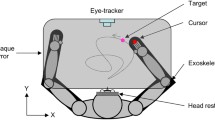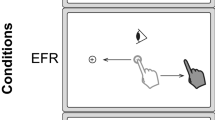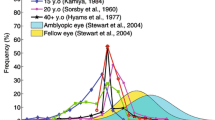Summary
The aim of this study was to examine coordination control in eye and hand tracking of visual targets. We studied eye tracking of a self-moved target, and simultaneous eye and hand tracking of an external visual target moving horizontally on a screen. Predictive features of eye-hand coordination control were studied by introducing a delay (0 to 450 ms) between the Subject's (S's) hand motion and the motion of the hand-driven target on the screen. In self-moved target tracking with artificial delay, the eyes started to move in response to arm movement while the visual target was still motionless, that is before any retinal slip had been produced. The signal likely to trigger smooth pursuit in that condition must be derived from non-visual information. Candidates are efference copy and afferent signals from arm motion. When tracking an external target with the eyes and the hand, in a condition where a delay was introduced in the visual feedback loop of the hand, the Ss anticipated with the arm the movement of the target in order to compensate the delay. After a short tracking period, Ss were able to track with a low lag, or eventually to create a lead between the hand and the target. This was observed if the delay was less than 250–300 ms. For larger delays, the hand lagged the target by 250–300 ms. Ss did not completely compensate the delay and did not, on the average, correct for sudden changes in movement of the target (at the direction reversal of the trajectory). Conversely, in the whole range of studied delays (0–450 ms), the eyes were always in phase with the visual target (except during the first part of the first cycle of the movement, as seen previously). These findings are discussed in relation to a scheme in which both predictive (dynamic nature of the motion) and coordination (eye and hand movement system interactive signals) controls are included.
Similar content being viewed by others
References
Bahill AT, Iandolo MJ, Troost BT (1980) Smooth pursuit eye movements in response to unpredictable target waveforms. Vision Res 20: 923–931
Bahill AT, McDonald JD (1983a) Smooth pursuit eye movements in response to predictable target motions. Vision Res 23: 1573–1583
Bahill AT, McDonald JD (1983b) Model emulates human smooth pursuit system producing zero-latency target tracking. Biol Cybern 48: 213–222
Bock O (1987) Coordination of arm and eye movements in tracking of sinusoidally moving targets. Behav Brain Res 24: 93–100
Boman DK, Hotson JR (1988) Stimulus conditions that enhance anticipatory slow eye movements. Vision Res 28: 1157–1165
Buizza A, Schmid R (1986) Velocity characteristics of smooth pursuit eye movements to different patterns of target motion. Exp Brain Res 63: 395–401
Buizza A, Schmid R (1989) Influence of smooth pursuit dynamics on eye tracking: a mathematical approach. Med Biol Eng Comput 27: 617–622
Carl JR, Gellman RS (1987) Human smooth pursuit: stimulusdependent responses. J Neurophysiol 57: 1446–1463
Dallos PJ, Jones RW (1963) Learning behavior of the eye fixation control system. IEEE Trans Autom Contr 8: 218–227
Domann R, Bock O, Eckmiller R (1989) Interaction of visual and non-visual signals in the initiation of smooth pursuit eye movements in primates Behav Brain Res 32: 95–99
Ebisawa Y, Minamitani H, Mori Y, Takase M (1988) New methods for removing saccades in analysis of smooth pursuit eye movement. Biol Cybern 60: 111–119
Erkelens CJ, Van Der Steen J, Steinman RM, Collewijn H (1989) Ocular vergence under natural conditions. I. Continuous changes of target distance along the median plane. Proc R Soc Lond, B 236: 417–440
Fender DH (1971) Time delays in the Human eye-tracking system P Bach-y-Rita, CC Collins, JE Hyde, Academic press
Foley JD (1987) Interfaces for advanced computing. Scientific American, 122: 83–90
Gauthier GM, Hofferer JM (1976) Eye tracking of self-moved targets in the absence of vision. Exp Brain Res 26: 121–139
Gauthier GM, Mussa Ivaldi F (1988) Oculo-manual tracking of visual targets in monkeys: role of the arm afferent information in the control of arm and eye movements. Exp Brain Res 73: 138–154
Gauthier GM, Vercher JL, Mussa Ivaldi F, Marchetti E (1988) Oculo-manual tracking of visual targets: control learning, coordination control and coordination model. Exp Brain Res 73: 127–137
Gellman RS, Carl JR, Miles FA (1990) Short latency ocular-following responses in man. Visual Neuroscience, 5: 107–122
Gielen CCAM, Van den Heuvel PJM, van Gisbergen, JAM (1984) Coordination of fast eye and arm movements in a tracking task. Exp Brain Res 56: 154–161
Jordan S (1970) Ocular pursuit movement as a function of visual and proprioceptive stimulation. Vision Res 10: 775–78
Kowler E (1989) Cognitive expectations, not habit, control anticipatory smooth oculomotor pursuit. Vision Res 29: 1049–1057
Kowler E, Martins AJ, Pavel M (1984) The effect of expectations on slow oculomotor control-IV Anticipatory smooth eye movements depend on prior target motions. Vision Res 24: 197–210
Kowler E, Steinman RM (1981) The effect of expectations on slow oculomotor control-III Guessing unpredictable target displacements. Vision Res 21: 191–203
Lackner JR, Evanoff JN (1977) Smooth pursuit eye movement elicited by somatosensory stimulation. Neurosci Let 4: 43–48
Lackner JR, Mather JA (1981) Eye-Hand tracking using afterimages. Evidence that sense of effort is dependent on spatial constancy mechanisms. Exp Brain Res 44: 138–142
Levine MS, Lackner JR (1979) Some sensory and motor factors influencing the control and appreciation of eye and limb position. Exp Brain Res 36: 275–283
Lisberger SG, Evinger LC, Johanson GW, Fuchs AF (1981) Relationship between eye acceleration and retinal image velocity during foveal smooth pursuit in Man and Monkey. J Neurophysiol 46: 229–249
Mather JA, Lackner JR (1980) Multiples sensory and motor cues enhances the accuracy of pursuit eye movements. Aviat Space Env Med 51: 856–859
Mather JA, Lackner JR (1981) The influence of efferent, proprioceptive, and timing factors on the accuracy of eye-hand tracking. Exp Brain Res 43: 406–412
McHugh DE, Bahill AT (1985) Learning to track predictable target waveforms without a time delay. Invest Ophthalmol Visual Sci 26: 932–937
Miall RC, Weir DJ, Stein JF (1985) Visuomotor tracking with delayed visual feedback. Neuroscience 16: 511–522
Michael JA, Melvill-Jones G (1966) Dependence of visual tracking capability upon stimulus predictability. Vision Res 6: 707–716
Neilson PD, Neilson MD (1980) Influence of control-display compatibility on tracking behaviour. Quart J Exp Psychol 32: 125–135
Ohashi N, Watanabe Y, Mizukoshi K (1987) Prediction in smooth pursuit. Acta Oto-Laryngologica 103: 131–136
Smith WM (1972) Feedback: Real-time delayed vision of one's own tracking behavior. Science 176: 939–940
Stark L, Kim WS, Tendick F, Hannaford B, Ellis S, Denome M, Duffy M, Hayes T, Jordan T, Lawton M, Mills T, Peterson R, Sanders K, Tyler M, Van Dyke S (1987) Telerobotics: display, control, and communication problems. IEEE J of Robotics and Automation 3: 67–75
Stark L, Vossius G, Young LR (1962) Predictive control of eye tracking movements. IRE Trans on Human Factors in Electronics 3: 52–57
Steinbach MJ (1969) Eye tracking of self-moved targets: the role of efference. J Exp Psychol 82: 366–376
Steinbach MJ (1976) Pursuing the perceptual rather than the retinal stimulus. Vision Res 16: 1371–1376
Steinbach MJ, Held R (1968) Eye tracking of observer-generated target movements. Science 161: 187–188
Steinman RM, Skavenski AA, Sansbury RV (1969) Voluntary control of smooth pursuit velocity. Vision Res 9: 1167–1175
Sugie N (1971) A model of predictive control in visual target tracking. IEEE Transactions on Systems. Man and cybern 1: 2–7
Van Den Berg AV (1988) Human smooth pursuit during transient perturbations of predictable and unpredictable target movement. Exp Brain Res 72: 95–108
Vercher JL, Gauthier GM (1988) Cerebellar involvement in the coordination control of the oculomanual tracking system: effects of cerebellar dentate nucleus lesion. Exp Brain Res 73: 155–166
Yasui S, Young LR (1984) On the predictive control of foveal eye tracking and slow phases of optokinetic and vestibular nystagmus. J Physiol 347: 17–33
Author information
Authors and Affiliations
Rights and permissions
About this article
Cite this article
Vercher, J.L., Gauthier, G.M. Oculo-manual coordination control: Ocular and manual tracking of visual targets with delayed visual feedback of the hand motion. Exp Brain Res 90, 599–609 (1992). https://doi.org/10.1007/BF00230944
Received:
Accepted:
Issue Date:
DOI: https://doi.org/10.1007/BF00230944




